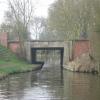
There is a bridge here which takes a road over the canal.
| Sedgley's Bridge No 9 | 7¾ furlongs | |
| Bowden Hall Winding Hole | 6 furlongs | |
| Bowden Hall Pipe Bridge | 5¼ furlongs | |
| Great Bowden Hall Bridge No 10 | 5¼ furlongs | |
| Saunt's Bridge No 11 | 3½ furlongs | |
| Uncle Tom's Bridge No 12 | ||
| Turnover Bridge No 13 | 1 furlong | |
| Site of Wooden Stepbridge No 14 | 2¾ furlongs | |
| Peter Callis Bridge No 14a | 2¾ furlongs | |
| Woodlands Winding Hole | 3¼ furlongs | |
| Woodlands Narrows | 4¾ furlongs | |
- Grand Union Canal Walk — associated with Grand Union Canal
- An illustrated walk along the Grand Union Canal from London to Birmingham
Mouseover for more information or show routes to facility
Nearest water point
In the direction of Market Harborough Wharf
In the direction of Foxton Junction
Nearest rubbish disposal
In the direction of Market Harborough Wharf
In the direction of Foxton Junction
Nearest chemical toilet disposal
In the direction of Market Harborough Wharf
In the direction of Foxton Junction
Nearest place to turn
In the direction of Market Harborough Wharf
In the direction of Foxton Junction
Nearest self-operated pump-out
In the direction of Foxton Junction
Nearest boatyard pump-out
In the direction of Foxton Junction
Wikipedia has a page about Uncle Tom's Bridge
Uncle Tom is the title character of Harriet Beecher Stowe's 1852 novel, Uncle Tom's Cabin. The character was seen by many readers as a ground-breaking humanistic portrayal of a slave, one who uses nonresistance and gives his life to protect others who have escaped from slavery. However, the character also came to be seen, especially based on his portrayal in pro-compassion dramatizations, as inexplicably kind to white slaveholders. This led to the use of Uncle Tom – sometimes shortened to just a Tom – as a derogatory epithet for an exceedingly subservient person or house negro, particularly one aware of their own lower-class racial status.




![Uncle Tom's Bridge [No 12], from the south-west. Carrying the former A6 [now the B6047] over the Market Harborough Arm [Leicester section of the Grand Union Canal]. This was a typical humpback bridge until the County Council rebuilt it in 1958, and reduced the navigation underneath from 14 feet to 12 feet. 'Uncle Tom' was probably Tom Foster, who owned a cafe here until the 1960s. The cafe had bowling greens, a croquet lawn and rowing boats for hire. by Christine Johnstone – 04 September 2017](https://s0.geograph.org.uk/geophotos/05/55/32/5553240_e54bd193_120x120.jpg)




![Grand Union Canal: Market Harborough Arm: Uncle Tom's Bridge. This is Bridge Number 12 along the Market Harborough Arm from Foxton Junction, but, since the bridges unusually have attractive nameplates instead of the ordinary number plates, it would seem churlish not to title the caption with the name. The bridge carries the B6047 (once the A6) Leicester Road to the right, or Harborough Road to the left, over the canal.It's taken us about 45 minutes and about 3.3 kilometres to get here from the previous B6047 crossing of the canal, at [[3474915]]. A car has a journey of about 1.4 kilometres and about 1 minute between the two bridges! by Nigel Cox – 07 May 2013](https://s2.geograph.org.uk/geophotos/03/47/50/3475074_eb88dee6_120x120.jpg)













![Turnover Bridge [No 13], from the south. Where the canal towpath changes sides. by Christine Johnstone – 03 September 2017](https://s3.geograph.org.uk/geophotos/05/55/27/5552795_bf488c70_120x120.jpg)


![Turnover Bridge, Market Harborough Arm. This is bridge no 13 on the arm, designed to allow the towpath to change from one side of the canal to the other without the need to unhitch the horse. Nowadays the towpath is used by cyclists and walkers. The appearance of graffiti is an indication that this is on the fringe of an urban area. It wasn't there two years earlier: [[3475093]] by Stephen McKay – 08 August 2015](https://s1.geograph.org.uk/geophotos/04/61/60/4616033_86093035_120x120.jpg)





